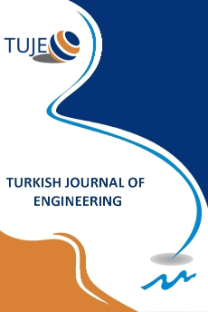Determination of the critical drop height and critical flow velocity of aluminum alloy (AL-91% Mg-8% Fe-0.4% Zn-0.2%) in gravity sand casting
Determination of the critical drop height and critical flow velocity of aluminum alloy (AL-91% Mg-8% Fe-0.4% Zn-0.2%) in gravity sand casting
Critical drop height, Critical velocity, Gravity sand casting Finite element method, Sprue,
___
- Feng L., (2008). Optimized Design of Gating/Riser System in Casting Based on CAD and Simulation Technology, Submitted to the faculty of the Worchester Polytechnic Institute in partial fulfillment of the requirements for degree of Master of science in Manufacturing Engineering.
- Attar E.H., Babaei R.P., Asgari K., Davami P., (2005). Modelling of air pressure effects in casting moulds, Journal of Modelling and Simulation in Materials Science and Engineering, 13, 903-917
- Lee P. D., Chirazi A., & See D. (2001). Modelling micro porosity in Aluminium - Silicon alloys: a review, Journal of Light Metals, 1, 15-30
- Sowa L. (1998). Model of the Casting Solidification taking into consideration the motion of liquid phase, Archives of Mechanical technology and Automatization, 18, 287 – 296
- Sowa, L., (2010). Mathematical Modelling of the Filling Process of a slender mould cavity, Scientific Research of the Institute of Mathematics and Computer Science, 9(2) 219-227
- Salih A. (2011). Conservation Equations of fluid Dynamics, Department of Aerospace Engineering, Indian Institute of space Science and technology, Thiruvananthapuram publishers 4-7
- Sowa L. & Bokota A. (2007). Numerical Modelling of Thermal and Fluid Flow Phenomena in the Mould Channel, Archives of Foundry Engineering, 7(4), 165 – 168.
- Sowa, L., (2010), Numerical Analysis of the Thermal and Fluid Flow Phenomena of the Fluidity test, Archives of Foundry Engineering, 10(1), 157 – 160.
- Bird R. B., Stewart W.E., & Lightfoot E.N., (2002). Transport Phenomena, 2nd edition, Wiley: NY.
- Aris, R., (1962). Vectors, Tensors, and the Basic Equations o Fluid Mechanics, Prentice Hall Publishers, Englewood Cliffs, NJ
- Ik-Tae I., Woo-Seung K., & Kwan-Soo L., (2001). A unified analysis of filling and solidification in casting with natural convection, International Journal of Heat and Mass Transfer, 44, 1507-1515
- Sowa, L., Sczygiol, N. Domoilski, T., & Bokota, A., (2008). Simplified Model of Metal Solidification in the Thin Plane Cavity of the Casting Mould, Archives of Foundry Engineering, 8(1), 309 – 312
- Bokota A. & Sowa L. (2010). Numerical Modelling of the thermal and fluid flow phenomena of the fluidity test, Archives of Foundry Engineering 10(1), 15–18
- Mishima S., & Szekely J. (1989). The modelling of fluid flow and heat transfer in mould filling, ISIJ International, 29(4), 324-332
- Majchrzak E., Jasinski M., & Kaluza G. (2004). Sensitivity analysis of solidification process with respect to the geometrical parameters of casting and mould, Archives of Foundry Engineering, 4(14) 279-284.
- Reddy J. N., (2006). An Introduction to the Finite Element Method, Third Edition, International Edition McGraw- Hill., 146 – 147, 441 - 442.
- Singiresu S. R. (2004). The Finite Element Methods in Engineering, fourth edition, Elsevier Science and Technology Books Publisher
- Hutton V. D. (2004). Fundaments of Finite Element Analysis, 1st Edition, McGraw-Hill Companies, Inc. 293 – 295
- Rohaya B. D. (2013). Design and Analysis of Casted LM6 - TIC in Designing of Production Tooling, Faculty of Manufacturing Engineering, Universiti Teknikal Malaysia Melaka (UTEM) 63 – 69
- Inegbedion F. and Akpobi J.A. (2019). Determination of the Critical Velocity of Molten Metal Flow in Casting Mould Sprue, International Journal of Engineering Trends and Technology (IJETT) – 67(10), 27 – 33.
- ISSN: 2587-1366
- Yayın Aralığı: Yılda 4 Sayı
- Başlangıç: 2017
- Yayıncı: Mersin Uüniversitesi
An alternative method for the particle size distribution: Image processing
Collapse capacity assessment of non-ductile open ground story reinforced concrete frame
Sentiment analysis with ensemble and machine learning methods in multi-domain datasets
Muhammet Sinan BAŞARSLAN, Fatih KAYAALP
Francis INEGBEDİON, James ORJI
Determination of optimum design parameters of glow plug and experimental verification
Muciz ÖZCAN, M. Fahri ÜNLERŞEN, Mehmet ŞEN
Design and walking analysis of proposed four-legged glass cleaning robot
Facile production of CsPbBr3 perovskite single-crystals in a hydrobromic solution
Murat ÖZEN, Cansu AKYEL, Songül AKBULUT ÖZEN
Yaşar Kemal RECEPOĞLU, Gülin GÜMÜŞBULUT, Aslı YÜKSEL ÖZŞEN
Enhancing the seismic performance of high-rise buildings with lead rubber bearing isolators
